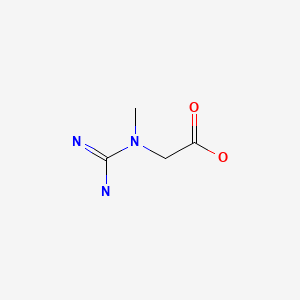Attribution Statement: LactMed is a registered trademark of the U.S. Department of Health and Human Services.
NCBI Bookshelf. A service of the National Library of Medicine, National Institutes of Health.
Drugs and Lactation Database (LactMed®) [Internet]. Bethesda (MD): National Institute of Child Health and Human Development; 2006-.
CASRN: 57-00-1

Drug Levels and Effects
Summary of Use during Lactation
Creatine is used as a dietary supplement to increase muscle mass and improve exercise performance. Creatine is a normal component of human milk, supplying about 9% of the infant’s daily requirements.[1] Milk levels of creatine have not been measured after exogenous administration in humans. Creatine is converted into creatinine in the mother's and infant's bodies. It may increase the infant's serum creatinine, which may alter estimations of the infant's kidney function.[2] Some authors speculate that creatine supplementation of nursing mothers might help avoid creatine deficiency syndromes, but no studies are available that test this hypothesis.[3] Until more data are available, it is probably best to avoid creatine supplementation unless it is prescribed by a healthcare professional.
Drug Levels
Milk levels of creatine have not been measured after exogenous administration in humans. Creatine is a normal component of human milk.
Maternal Levels. One study found the concentration of creatine to average 25.8 mg/L in normal mothers 3 to 5 days postpartum (n = 3), 18.7 mg/L in mothers 6 to 14 days postpartum (n = 16), and 11.5 mg/L in individual mothers over 15 days postpartum (n = 16). The creatine concentration was 10.1 mg/L in pooled milk from mothers over 15 days postpartum (n = 10).[2]
The creatine concentration in the breastmilk of 3 women was measured. The average concentration was 113 mg/L.[4]
Infant Levels. Relevant published information was not found as of the revision date.
Effects in Breastfed Infants
Relevant published information was not found as of the revision date.
Effects on Lactation and Breastmilk
Relevant published information was not found as of the revision date.
References
- 1.
- Garwolinska D, Namiesnik J, Kot-Wasik A, et al. Chemistry of human breast milk-a comprehensive review of the composition and role of milk metabolites in child development. J Agric Food Chem. 2018;66:11881–96. [PubMed: 30247884]
- 2.
- Hulsemann J, Manz F, Wember T, et al. Klin Padiatr. 1987;199:292–5. [Administration of creatine and creatinine with breast milk and infant milk preparations] [PubMed: 3657037]
- 3.
- Wallimann T, Tokarska-Schlattner M, Schlattner U. The creatine kinase system and pleiotropic effects of creatine. Amino Acids. 2011;40:1271–96. [PMC free article: PMC3080659] [PubMed: 21448658]
- 4.
- Peral MJ, Galvez M, Soria ML, et al. Developmental decrease in rat small intestinal creatine uptake. Mech Ageing Dev. 2005;126:523–30. [PubMed: 15722111]
Substance Identification
Substance Name
Creatine
CAS Registry Number
57-00-1
Disclaimer: Information presented in this database is not meant as a substitute for professional judgment. You should consult your healthcare provider for breastfeeding advice related to your particular situation. The U.S. government does not warrant or assume any liability or responsibility for the accuracy or completeness of the information on this Site.
- User and Medical Advice Disclaimer
- Drugs and Lactation Database (LactMed) - Record Format
- LactMed - Database Creation and Peer Review Process
- Fact Sheet. Drugs and Lactation Database (LactMed)
- Drugs and Lactation Database (LactMed) - Glossary
- LactMed Selected References
- Drugs and Lactation Database (LactMed) - About Dietary Supplements
- Breastfeeding Links
- PMCPubMed Central citations
- PubChem SubstanceRelated PubChem Substances
- PubMedLinks to PubMed
- Alterations in biochemical markers due to mercury (Hg) exposure and its influence on infant's neurodevelopment.[Int J Hyg Environ Health. 2016]Alterations in biochemical markers due to mercury (Hg) exposure and its influence on infant's neurodevelopment.Al-Saleh I, Elkhatib R, Al-Rouqi R, Abduljabbar M, Eltabache C, Al-Rajudi T, Nester M. Int J Hyg Environ Health. 2016 Nov; 219(8):898-914. Epub 2016 Jul 2.
- Review Alcohol.[Drugs and Lactation Database (...]Review Alcohol.. Drugs and Lactation Database (LactMed®). 2006
- Creatine and guanidinoacetate content of human milk and infant formulas: implications for creatine deficiency syndromes and amino acid metabolism.[Br J Nutr. 2013]Creatine and guanidinoacetate content of human milk and infant formulas: implications for creatine deficiency syndromes and amino acid metabolism.Edison EE, Brosnan ME, Aziz K, Brosnan JT. Br J Nutr. 2013 Sep 28; 110(6):1075-8. Epub 2013 Feb 7.
- Review Glycolic Acid.[Drugs and Lactation Database (...]Review Glycolic Acid.. Drugs and Lactation Database (LactMed®). 2006
- Review Beta-Carotene.[Drugs and Lactation Database (...]Review Beta-Carotene.. Drugs and Lactation Database (LactMed®). 2006
- Creatine - Drugs and Lactation Database (LactMed®)Creatine - Drugs and Lactation Database (LactMed®)
Your browsing activity is empty.
Activity recording is turned off.
See more...
